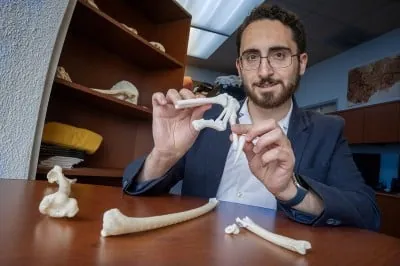
Revolutionizing Flight: New Discovery of Dinosaur Wrist Bone Shakes Up Evolutionary Theory
2025-07-09
Author: Wei Ling
In a stunning breakthrough, researchers at Stony Brook University have uncovered a shocking truth about theropod dinosaurs that could reshape our understanding of how flight evolved. Their analysis of two distinct theropod fossils revealed the presence of a carpal bone known as the pisiform, previously thought to be exclusive to birds and crucial for flight.
Led by Dr. James Napoli, this groundbreaking study, published in the prestigious journal Nature, challenges long-held beliefs that theropods, the dinosaur group from which birds descended, lacked this vital wrist structure. The implications of this find suggest that the origins of flight might have been intricately tied to the evolution of wrist anatomy.
For years, the carpal bones in the wrists of birds posed a scientific enigma, but researchers have now confirmed that the pisiform—a bone that evolved from a kneecap-like structure—plays a key role in the mechanics of bird flight. Its distinct design allows modern birds to fold their wings automatically and prevents injuries during flight, showcasing its crucial role in avian evolution.
The fossils examined in the study included a troodontid, a raptor closely related to the Velociraptor, and an oviraptorid, a unique omnivore characterized by its long neck and toothless beak. Thanks to exceptional fossil preservation and advanced high-resolution CT scanning technology, the research team was able to digitally separate wrist bones, revealing tiny, migrated pisiforms—a first for non-bird dinosaurs.
"This is a pioneering identification of a migrated pisiform in meat-eating dinosaurs," stated Dr. Napoli, emphasizing the evolutionary significance of the discovery. "While we don't yet know how many times flight evolved in dinosaurs, our findings indicate that this migrated bone might have enabled experimental flight. This opens the door to exploring the automated flight mechanisms found in modern birds, but further research is needed to test this hypothesis."
This study places the pisiform's transition not within the lineage of birds, but deeper within the evolutionary tree, specifically to a group called Pennaraptora, which includes theropods like dromaeosaurids and troodontids. This is the very group in which bird-like characteristics, including feathers and potentially the ability to fly, began to emerge multiple times.
Dr. Napoli and his collaborators concluded that the evolutionary replacement of the ulnare bone by the pisiform occurred earlier than previously believed, suggesting a more complex evolutionary landscape for theropod bones. Their insights highlight how traits typically associated with birds—such as lightweight bones, larger brains, and feathers—are found in a broader array of theropod dinosaurs.
Overall, this discovery paints a fascinating picture of the evolutionary journey toward flight, suggesting that the development of bird-like features was a gradual and intricate process, firmly rooted in the long history of theropod evolution.



 Brasil (PT)
Brasil (PT)
 Canada (EN)
Canada (EN)
 Chile (ES)
Chile (ES)
 Česko (CS)
Česko (CS)
 대한민국 (KO)
대한민국 (KO)
 España (ES)
España (ES)
 France (FR)
France (FR)
 Hong Kong (EN)
Hong Kong (EN)
 Italia (IT)
Italia (IT)
 日本 (JA)
日本 (JA)
 Magyarország (HU)
Magyarország (HU)
 Norge (NO)
Norge (NO)
 Polska (PL)
Polska (PL)
 Schweiz (DE)
Schweiz (DE)
 Singapore (EN)
Singapore (EN)
 Sverige (SV)
Sverige (SV)
 Suomi (FI)
Suomi (FI)
 Türkiye (TR)
Türkiye (TR)
 الإمارات العربية المتحدة (AR)
الإمارات العربية المتحدة (AR)